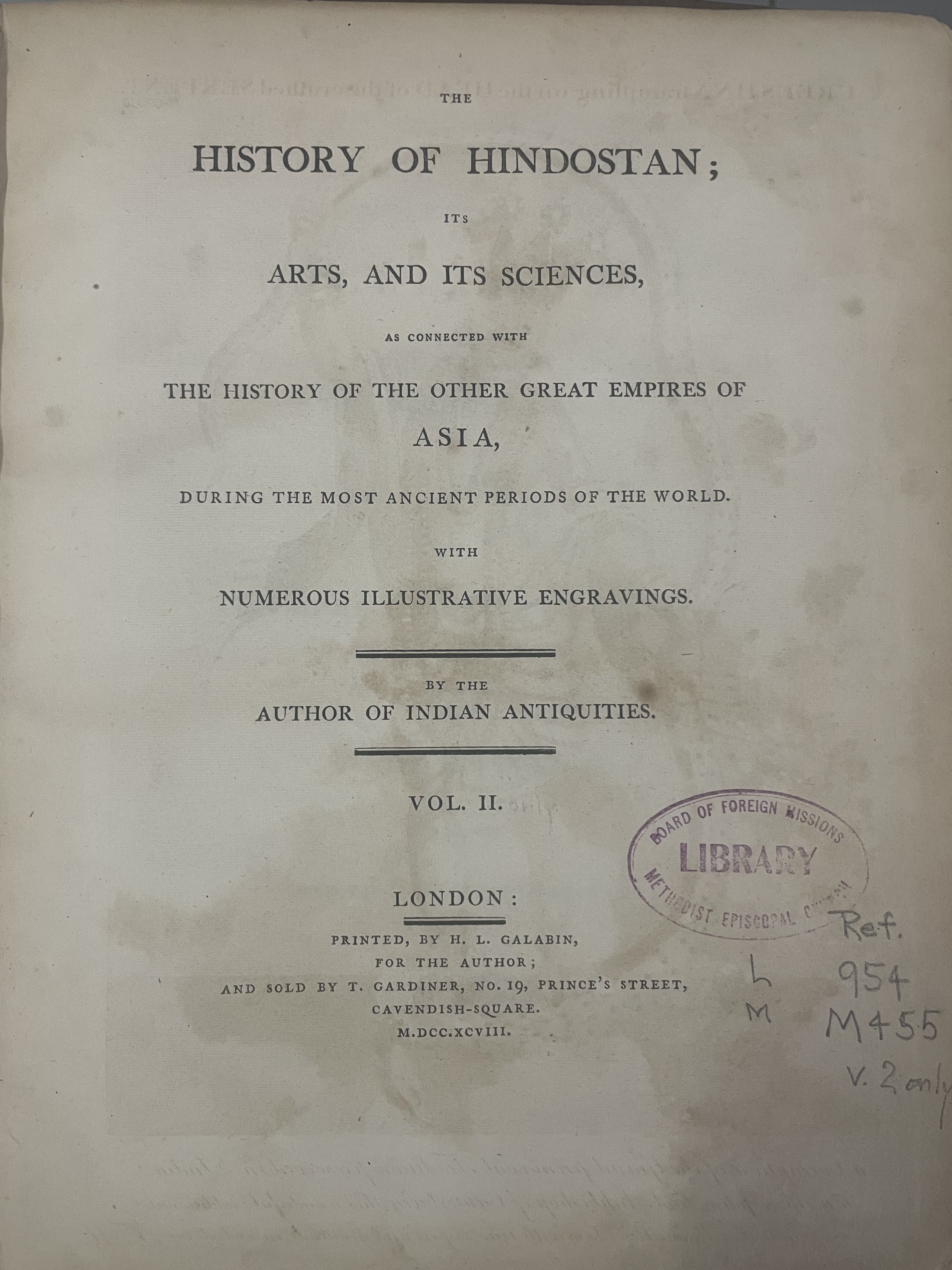The History of Hindostan : Its Arts and its Sciences as connected with The Other Great Empire of Asia vol 2

About
Summary
Exquisite
TOC
Details
Related
URL
Images
Overview
The History of Hindostan: Its Arts, and Its Sciences, as Connected with the History of the Other Great Empires of Asia, During the Most Ancient Period, Volume 2, authored by Thomas Maurice and published in 1798, continues the ambitious project of exploring India's historical narrative, intertwined with its artistic and scientific achievements within the broader context of Asian empires. This volume specifically delves into the post-diluvian ages and the Indian avatars.Thomas Maurice, an English orientalist, sought to uncover and present the ancient glories of India, connecting its cultural and intellectual developments to its interactions with other significant Asian civilizations. Volume 2 delves into specific aspects of ancient Indian history and mythology, with a focus on religious and philosophical elements1.
Indian Avatars: Volume 2 details the history of seven remaining Indian avatars, beginning with the fourth incarnation of Veeshnu (Vishnu) in the form of Nara-Sing, or the Man-Lion, to destroy a blaspheming Monarch1. The fifth incarnation of Veeshnu is in the form of Bahmun, the Dwarf. The sixth incarnation of Veeshnu is in the form of Parasu-Rama. The seventh incarnation of Veeshnu is in the form of Rama-Chandra. The eighth incarnation of Veeshnu is in the form of Creeshna, with an extensive life of that favorite deity of the Indians, from the Puranas1. The ninth incarnation of Veeshnu is in the form of Buddha. The tenth, or future, Incarnation of Veeshnu is in the Form of Calci, an armed Warrior, brandishing a blazing Cime- ter, and riding on a white Horse, like the crowned Hero in the Apocalypse, to dissolve the Universe1.
Post-Diluvian Ages: Volume 2 details the events of the earliest post-diluvian ages and alludes to the Mosaic ark and the general deluge1.
Geographical and Cultural Context: Interwoven with the mythological and religious narratives, the book seeks to ground these accounts in a geographical and cultural reality, exploring the customs, manners and language of Hindostan.
Importance of Book
Comprehensive Historical Account: It provides a detailed historical account of India, focusing on religious narratives and figures from ancient times, and their influence1. The scale and scope of the project reflect the ambition to encapsulate India's vast and complex past.
Cross-Cultural Synthesis: Dow's work attempts to bridge the gap between Eastern and Western perspectives, offering a synthesis of Persian and European views on Indian history and culture.
Influence on Colonial Understanding: The book influenced British understanding of India during the colonial period, shaping perceptions of Indian society, governance, and culture.
Preservation of Sources: By translating and incorporating Persian chronicles and Sanskrit verses, Dow preserved valuable historical information that might otherwise have been lost to Western audiences
Key Themes
Religious Syncretism and Mythology: A central theme is exploring the syncretic nature of Indian religions and mythologies. This is evident in the descriptions of Vishnu's avatars1. Maurice likely sought to connect these narratives to a broader understanding of religious thought in Asia, exploring parallels and divergences.
Ancient Wisdom and Philosophical Depth: Volume 2 explores the ancient wisdom and philosophical depth of Indian thought1. By explaining core tenets and connecting them to daily life, the book emphasizes the sophistication and intellectual contributions of ancient Indian civilization.
Interconnectedness of Knowledge and Culture: Throughout the book, Maurice underscores the interconnectedness of knowledge and culture in shaping Indian civilization. By linking artistic achievements, scientific advancements, religious beliefs, and social structures, he presents a holistic view of Indian society.
The Influence of Geography and Climate: Maurice underscores the influence of geography and climate in shaping Indian civilization. By highlighting how natural features and environmental conditions influenced agricultural practices, trade routes, and cultural adaptations, he connects Indian history to its geographical context.
Cultural Significance
Literary Contribution: As an early example of historical writing about India from a European perspective, it contributed to travel literature by providing insights into life during a critical period in Indian history. It shows ancient tradition through myth and story.
Foundation for Historical Studies: The book lays groundwork for future studies on colonialism by documenting interactions between different civilizations while also reflecting on power dynamics at play during this period.
Intercultural Dialogue: By presenting multiple viewpoints on cultures around the world, it fosters dialogue about tolerance, understanding, and appreciation for diversity among readers.
Reflection on Imperial Attitudes: The narratives reflect imperial attitudes prevalent during their times while also offering critiques that can lead to discussions about imperialism's legacy today.
Effects on Society
Shaping European Perspectives: The book played a crucial role in shaping European views about India during a time when many were unaware of its rich history and cultural diversity.
Stimulating Interest in Indian History: Maurice’s detailed descriptions sparked interest among Europeans regarding Indian culture and history, leading to increased scholarly pursuits in understanding Indian society.
Influencing Colonial Policies: The insights provided by Maurice influenced colonial policies as European powers sought to establish their presence in India based on economic interests highlighted in his commentary.
Cultural Reflection: The book encouraged readers in Europe to reflect on their own beliefs concerning those they encountered abroad, fostering curiosity about different worldviews.
Conclusion
The History of Hindostan: Its Arts, and Its Sciences, as Connected with the History of the Other Great Empires of Asia," Volume 2, by Thomas Maurice, is a valuable historical resource that offers insights into Indian history, culture, and society. Its exploration of Indian mythology, religious syncretism, and interconnections with other Asian empires contribute to a broader understanding of India's rich and diverse heritage.
Title
The History of Hindostan : Its Arts and its Sciences as connected with The Other Great Empire of Asia vol 2
Author
Thomas Maurice
Name of Publisher
H L Galabin
Publish Date
1798
Subject
This structure provides a comprehensive view of Hindostan?s contributions to arts and sciences within the broader Asian context.
Vintage
1701-1800
Edition
First
Number of Pages
705
Category
Hindu studies
Sub Category
Social Sciences
Rarity
RARE
